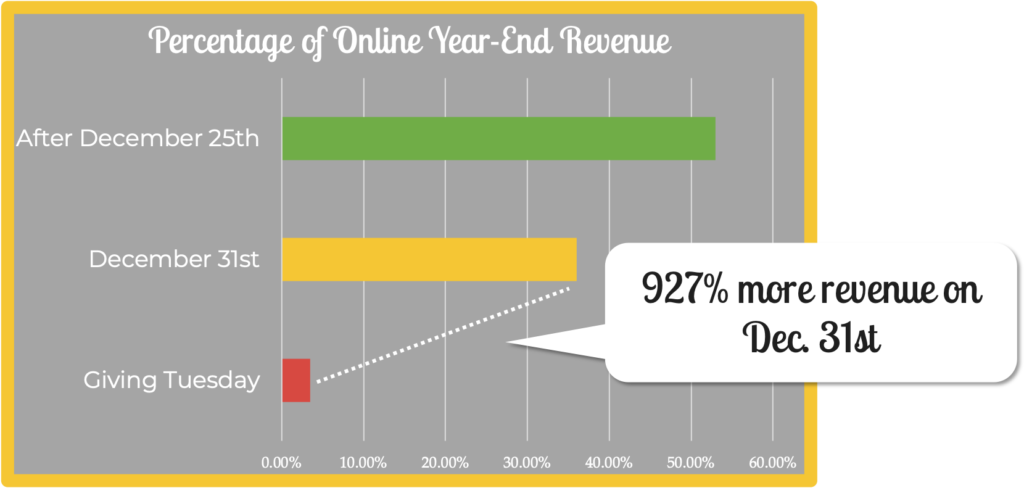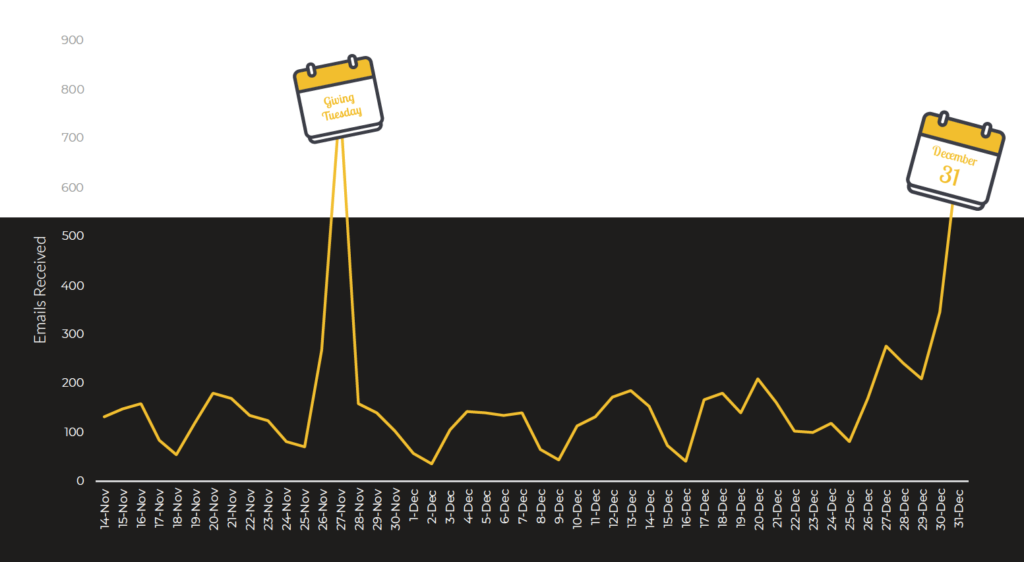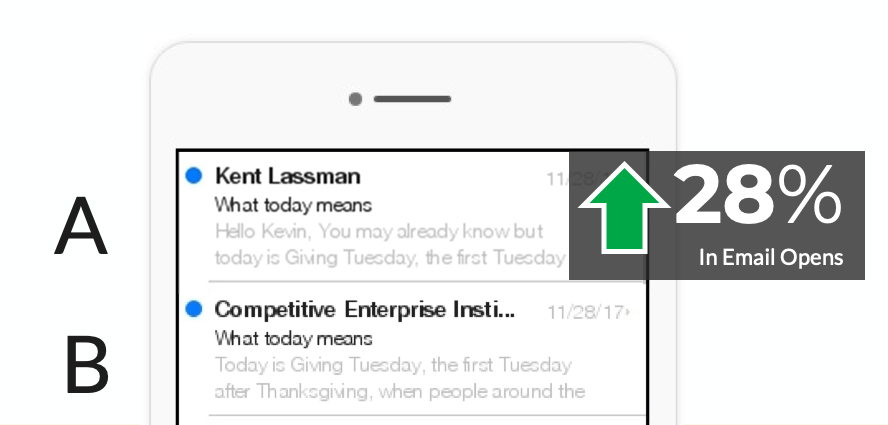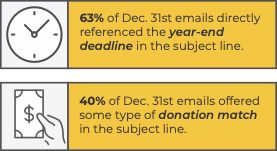We use cookies to ensure that we give you the best experience on our website. By continuing to use this site, you agree to our use of cookies in accordance with our Privacy Policy.
 Login
Login
Your Role
Challenges You Face
results
Learn
Resources
Company
5 Online Year-End Fundraising Stats You Can Use to Help Craft Your Campaign


This guest post on year-end fundraising stats is from Nathan Hill at NextAfter.
Every development professional understands the importance of year-end fundraising. The key to success at year-end is equally as well understood, but much harder to execute: to actually be seen and heard by your donors during one of the busiest times of the year.
Here are 5 quick online year-end fundraising stats that can help you cut through the year-end fundraising clutter with your communications. Each finding was discovered by analyzing over 7,000 year-end emails from 2018, and the online revenue metrics of 25 organizations with active online programs.
Enjoy!
#1. Giving Tuesday is not as important as December 31st.
Every time we (my colleagues and I at NextAfter) say this, either in a blog post or on a webinar, people often assume we’re against Giving Tuesday. That couldn’t be further from the truth!
But everything needs to be held in the right priority. And it’s hard to argue with the revenue data when you compare Giving Tuesday to December 31st.
Just take a look at the chart below…

According to our data-set, Giving Tuesday brought in 3.5% of online year-end revenue. That’s not insignificant.
But December 31st brought in 36% of all online year-end revenue in a single day. And the last week of the year as a whole brought in 53% of all online year-end revenue.
While Giving Tuesday is growing in importance and value each year, we have to keep our time and efforts in the right priority. The revenue numbers show that the top priority is December 31st.
Now, the next question you might ask is… “Well, Nathan, could it be that Giving Tuesday isn’t as valuable because we aren’t focused on it enough?”
That’s what I wondered as well…which brings us to year-end fundraising stat number two.
#2. Fundraisers spent more effort trying to fundraise on Giving Tuesday than they did on December 31st.
In fact, nonprofits sent 16.8% more emails on Giving Tuesday than they did on December 31st, despite December 31st bringing in 927% more online revenue.

Regardless of your stance on the email overload that occurs on Giving Tuesday, what’s even more striking is the sheer number of organizations that didn’t participate at all.
42% of organizations didn’t email on Giving Tuesday at all. And 48% of organizations didn’t email on December 31st at all.
The biggest takeaway that we need to draw here is this…
There are a lot of donations at stake during year-end, but you can’t expect people to give if you never actually ask them to donate.
Now, if you are asking for donations, what do those communications look like?
#3. Most year-end emails come from non-human senders.
64% of emails received during the 2018 year-end season were sent from non-human senders.

What is a non-human sender? Basically, it’s any email where the sender line doesn’t contain a real person’s name. That includes “Do Not Reply” senders, but it also includes emails sent just from the name of an organization like “American Red Cross.”
(P.S. I’m not picking on American Red Cross. They’re just the first organization name that came to mind.)
Why does it matter if you send emails from a real person or not? Let me show you an experiment.

In the experiment above, you see that Version A was sent from a real person. Version B was sent from the name of the organization.
Now, the preview text is slightly different as well. The key difference here is that Version A looked and sounded more like a human. And Version B looked and sounded more like marketing.
The email that looked and sounded more human saw a 28% increase in opens, which gives greater opportunity to win a donation.
We’ve also seen that emails sent from a real person’s name have a higher likelihood of making it to the primary inbox. On the other hand, emails sent from an organization may come across as spammy and be relegated to a “promotions” folder or tab. When it comes to year-end fundraising stats, this one should be top of mind.
#4. Most year-end emails are being sent at the same time.
During such a busy season, it’s easy for your emails to get overlooked simply because your donor’s inbox is so crowded. But there’s good news. We found times during the week where you might have a greater chance of getting your donor’s attention.
In the heat-map above, the times highlighted in red have the most crowded inbox. The busiest times are Mondays, Tuesdays, Thursdays, and Fridays from 7am to Noon (central time).

It’s a bit less crowded in the early mornings as well as evenings during the week.
And the year-end inbox is the least crowded on weekend afternoons and evenings. We’ve actually found that weekend emails can tend to have higher average gift sizes since donors have more time to contemplate how much they might give.
Consider sending an email or two on a weekend afternoon to make sure your organization stays top of mind.
#5. Nonprofits are all saying the same things.
At the end of the day, your message is truly the most important and vital tool in your tool kit to inspire donors to give to you. But if you’re saying the same exact things as everyone else, you might just get overlooked.
And looking at December 31st specifically, we found that organizations are all saying virtually the same thing.

63% of organizations specifically reference the end of year deadline in their subject lines. And 40% of organizations offer some type of match directly in the subject line.
Now, normally, these are each a great method of incentivizing someone to give now because they create a sense of urgency.
But it has to make you wonder if the message actually gets diluted because everyone is saying the same things at the same time. Here are some common examples of subject lines we saw:
- Quick, before midnight!
- URGENT: One request before midnight
- Down to the wire
- At midnight, our QUADRUPLE match offer expires
- LAST CHANCE to give in 2018
- It expires tonight!
If everything is urgent, is anything really urgent?
It may be worth testing a subject line that stands out from the typical “Last chance to give.” Test employing a bit more of implied utility or value in your subject line to try and win an open.
And if you want other tested and proven strategies to implement into your emails and donation pages this year-end, you can check out this post on 5 Year-End Fundraising Ideas to Actually Grow Your Revenue.
At the end of the day, year-end fundraising is really quite similar to all other sorts of fundraising: you need to engage, build relationships, and provide value to your donors (not always solicit). At year-end however, competition for donor attention is high. Refer to these stats above, stay the course, and find year-end giving success right around the corner!
About NextAfter
NextAfter is 3 things: a fundraising research lab, a digital fundraising consultancy, and an institute for online fundraising. These three things are centered around our mission to decode what works in fundraising, make it as accessible to as many nonprofits as possible, and unleash the most generous generation in history.

About Nathan
Nathan is the Marketing Director for NextAfter. He spends every day working to help nonprofit organizations discover how testing and optimization can transform their marketing and fundraising, leading to greater impact and organizational growth. He is also a giant Star Wars nerd.
Get smarter with the SmartIdeas blog
Subscribe to our blog today and get actionable fundraising ideas delivered straight to your inbox!
